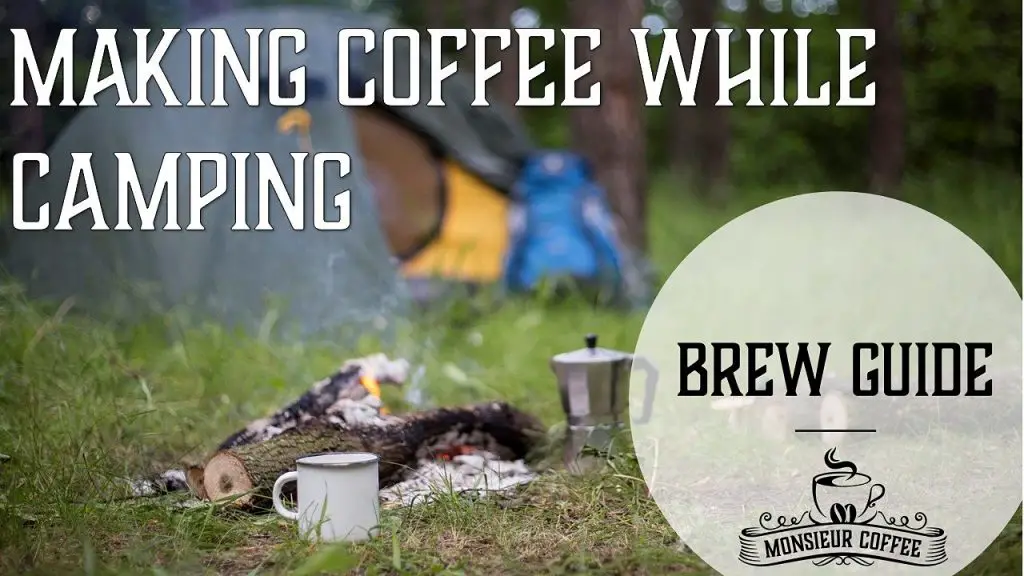When the snow melts, the trees grow new leaves, and shorts or skirts and t-shirts start to dominate our wardrobe, you know: summer is here, and it’s time to venture out into the wild.
I love camping. Messing around in nature. Living with little of the comforts you know from home and just relax. It charges my batteries to the max! And I know I am not alone.
There is only one thing I don’t want to miss. Not even when I am far from civilization. A great cup of coffee. Fortunately, I have found that there is no need to start drinking instant coffee when you are out and about.
So, how to make coffee while camping. And more importantly: how to make GOOD coffee while camping?
First, there is no way you are going to be able to bring your automatic coffee bean grinder, shiny espresso machine, or your trusty drip coffee maker into the wood. Where are you going to get power from? And obviously, those machines are way to big and heavy and a pain to lug around.
Off course you’re not even thinking about bringing that stuff camping. Right?
And as said, there is no need.
In this article, I will go through several ways to make excellent coffee that is ideal for your next camping trip.
How to make coffee With a moka pot while camping
First, let’s take a look at the Moka Pot. A device usually made of aluminum that you can put on a heat source and with which you can make a strong cup of coffee.
Using a Moka Pot is easy. You unscrew the halves, and in the bottom part, you will find a filter tray. Fill the lower part with water, put the filter container back in and drop in your ground coffee beans.
Screw the top half back on and put it all on your heat source. After a few minutes, you will hear the water start bubbling away. The boiling action allows the water to finds its way up the Moka Pot, through the ground coffee beans, and into the upper half of the pot. When the water has bubbled through, your coffee is made.
When you make coffee with Moka POt, expect a strong cup of coffee. This is because the water that passes through the coffee is quite hot.
When the water starts to boil, it builds up pressure, and this allows the water to pass up through the pot into the filter with the ground coffee. The general rule is the hotter the water, the more extraction in the least amount of time. So, because the water in a Moka Pot is at boiling temperatures when it reaches the coffee, a lot of extraction takes place. Especially the extraction of bitter flavors. If you don’t use the Moka Pot correctly, it’s easy to end up with a strong and quite bitter cup of coffee.
One way to remedy this a bit is to reduce the heat when the water starts boiling slowly. If you are heating the Moka Pot over a fire, you’ll need to remove the pot from the heat source altogether. Whether this leaves enough residual heat to push most of the water through the coffee is a matter of experimentation.
If the coffee still comes out too strong, you can try to dilute it a bit with some hot water. Americano style.
Although technically coffee from a Moka Pot is not espresso (the pressure is too low), I often hear that people do use the coffee as a basis for a cappuccino or any other milk based coffee. If you want to try to make a cappuccino or latte while camping you can try to heat up some milk in a pan and froth it using one of those handy-dandy battery-operated frothing wands. I have tried this, and while you won’t be able to produce a barista quality drink, it’s still an excellent method for when you are out camping.
A personally tested Moka Pot recipe
What you’ll need for two cups of Moka pot coffee:
- A Moka Pot
- 14 grams of coffee ground slightly coarser than you would for an espresso
- 140 ml (4.75 oz) of water
Step 1: unscrew the Moka Pot
Step 2: put the water in the bottom half
Step 3: put the filter bed in the bottom half and put in the ground coffee
Step 4:
screw on the top
Step 5: put
it on a heat source and wait for the water to start boiling
Step 6:
when the coffee starts coming out of the tube in the top half, turn down your
heat source to low or take is of the fire altogether (experiment!)
Step 7:
wait for the coffee to stop coming out of the tube in the top half, and you’re
done!
Step 8:
pour the coffee into cups and enjoy while listening to the birds.
Moka Pot Pros
- Cheap to purchase and readily available
- Moka Pots are usually quite sturdy and can take a beating
moka pot cons
- High risk of over-extraction, and therefore bitter coffee, due to high water temperature
- The cups of coffee that you make with it are small in volume
- It can take a long time before all the water has run through the coffee
If you are interested in using a Moka Pot on your next camping trip, you might be interested to know: this is the Moka Pot I prefer to use.
How to make Pour-over coffee while camping
Making old-fashioned coffee with a filter is part of the primitive image of camping. Boil the water on the fire and pour it on the ground coffee bean. Simple, and old-school. Or is it?
The old-fashioned pour-over method has returned to the hip and happening coffee business in the last decade. Every trendy coffee bar nowadays has barista working with specialty coffee beans, dialed in water temperatures, man buns, and stopwatches to make you a perfect (and pricey!) filter coffee they usually refer to as ‘slow coffee.’
Essentially, nothing new. Just the pouring of hot water on a bed of good quality ground coffee beans. To be fair, I love pour-over coffee. I make it every day at home
And for camping, it is the ideal method. All you need is a filter cone (or coffee dripper as they are also known), filters, a way to heat water and a cup or thermos to put the filter cone on.
Any filter cone will do. Preferably a plastic one as these don’t break as easily as a glass or ceramic one. Pretty important when you’re outdoors. Things tend to get banged around. You can make do with a cheap one for a couple of bucks, or you can spend a bit more and get a Hario V60. In my opinion, the best filter cone on the market today. Just be sure you buy the right filters for your dripper.
A new and really useful innovation when you’re hiking and have to carry everything on your back is this collapsible silicone filter cone.
A few tips to help you make the best pour over filter coffee while camping:
Before you put the ground coffee beans in, first wet the paper filter. This washed out most of the paper taste.
When the water for your coffee is boiling, take it off the heat and wait for one minute (shorter when it’s cold) before you start pouring. Pouring on water that is a little below boiling temperatures (85-90 degrees) will result in a smoother and more flavorful cup of coffee. The hotter the water, the more bitter flavor compound will get extracted. Don’t wait too long, though! If the water is too cold, you might end up with an overly acidic coffee. Waiting for one minute after boiling is a good rule of thumb, but feel free to experiment with adjusting the coffee to your taste.
Grind your coffee medium coarse. If you use pre-ground coffee, find the coarse ground version that can also be used for French Press brews.
A personally tested pour-over coffee recipe
What you’ll need for a big mug, or a pint-sized thermos of pour-over coffee:
- A pour-over coffee maker (cone)
- Coffee filters
- 30 grams of coffee, ground medium-coarse
- 500 ml (17 oz) of water, plus a bit to wash out the filter
Step 1: boil the water and put the filter in the filter cone
Step 2: wet the filter and allow to drain to wash out the paper taste
Step 3: put the coffee in the filter
Step 4: pour enough water on the ground coffee to thoroughly wet the grounds. Wait for 30 seconds. This is called the bloom, and it allows trapped carbon dioxide to ‘gas’ out.
Step 5: pour in the rest of the water in three stages. Allow the water to drain before adding more water but don’t let the bed of coffee grounds fall completely dry.
Step 6: after the last pour, allow to drain completely and enjoy!
The whole process from the pour for the bloom to the drain after the last of the water has been added, should take about four minutes. If it takes longer or shorter, and you don’t like to coffee, adjust the grind size (if you have a coffee grinder in your bag). Grind coarser for a shorter brew time (or a less bitter coffee), finer for a longer brew time (or a more full-bodied, but also slightly more bitter coffee).
Pour-over filter coffee Pros
- Most people have a plastic filter and filter paper lying around. If you’re not one of those people, it’s pretty inexpensive to get it.
- You can make a large cup or multiple cups of coffee with this method. Or you can even fill a thermos which will last you all morning.
- The paper filters do not take up any space and will fit somewhere in your bag. The pour-over filter cone, if made from plastic, can take a beating.
- You can control all parameters yourself. By experimenting (lowering or increasing the water temperature, using more or less ground coffee, grinding coarser or finer) you can dial in the perfect cup of coffee to your taste.
Pour-Over Filter Coffee cons
- It takes a while to make a cup of coffee. But hey, relax, you’re outdoors.
- The best pour over filter coffee is made by grinding your coffee quite coarse. This means you’ll have to bring your own grinder as coarse pre-ground coffee is not always available.
How to make coffee with an aeropress while camping
One of the most foolproof and fuss-free methods of making coffee on the go is the Aeropress. I have been using an Aeropress for a couple of years now. And it is one of my favorite devices to make a cup of coffee. Anywhere. At home, at work, but especially when I am in the great outdoors.
While I just said I love pour-over coffee, when camping I prefer the Aeropress. The Aeropress is virtually indestructible, easy to use, and easy to clean. And it allows you to make coffee in literally no time.
My preferred method has a brewing time of 1 minute and 30 seconds before the ‘plunge’ (more on that later). A pour-over takes me at least four minutes and making coffee in a Moka Pot even longer.
But the best thing is the coffee. So clean and crisp. Almost as good as the perfect pour over. But the perfect pour over is difficult to make. Especially under less than ideal conditions. The Aeropress is consistent. Great coffee. Every time.
To make a great cup of Aeropress coffee, you just need to keep in mind that timing is everything. You don’t want to over-extract. So use a timer, (stop)watch or the one-Mississippi-two-Mississippi… method.
I personally always use the so-called inverted method. This is where you put your Aeropress upside down to load is with coffee and water, and flip it over when it is time to plunge.
So, here’s the way to do it.
A personally tested aeropress coffee recipe
What you’ll need for a small mug of aeropress coffee:
- An Aeropress
- Aeropress coffee filters
- 16 grams of coffee, ground medium-coarse
- 200 to 250 ml (6.75 to 8.5 oz) of water, plus extra to wash out the filter and preheating the vessel
Step 1: boil your water, pour some hot water in the Aeropress, and allow the rest to cool for two minutes.
Step 2: put the paper filter into the cap and pour on a bit of hot water to rinse out the paper taste.
Step 3: pour the water from the Aeropress into your cup and put the coffee grounds in the Aeropress.
Step 4: pour enough water on the ground coffee to completely wet the grounds. Wait for 30 seconds. This is called the bloom, and it allows trapped carbon dioxide to ‘gas’ out.
Step 5: pour on the rest of the water until to Aeropress is filled to the rim, knock down the ‘crust’ of coffee that has formed at the top and put on the filter cap.
Step 6: At the 1:30 minute mark, flip over the Aeropress onto a cup, and start the plunge. Apply enough force to empty the Aeropress within 30 – 45 seconds. Stop plunging when you hear air escaping. Enjoy!
Pour-over filter coffee Pros
- Easy to use and easy to carry around
- Virtually indestructible
- Yields a full mug of coffee
- Can be used literally anywhere (there is even an Aeropress Mile High Club!)
- Fully controllable. Adjust grind size, water temperature, the amount of coffee or water, to find the perfectly balanced cup of coffee
Pour-Over Filter Coffee cons
- I can think of only one: you’ll need to get special filters for an Aeropress, which might not be readily available when you run out in the middle of a camping trip.
conclusion
Camping is a great way to spend some time off in nature. And there’s no need to make compromises in terms of the quality of the coffee you drink when you are out there. I hope to have shown that there are easy to use methods to make a great cup of coffee in the outdoors.
There it is, now you now how to make coffee while camping.
Happy camping.
Monsieur Coffee





